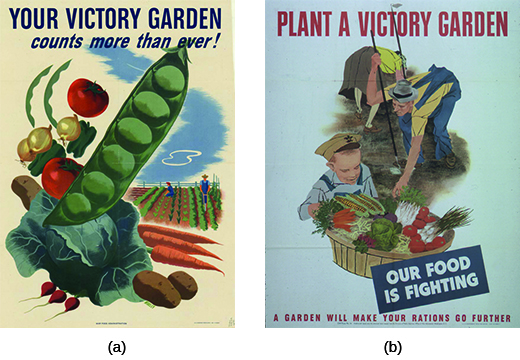Chapter 27: Fighting the Good Fight in World War II 1941-1945
1/22
There's no tags or description
Looks like no tags are added yet.
Name | Mastery | Learn | Test | Matching | Spaced |
|---|
No study sessions yet.
23 Terms
During World War II, the U.S. had a labor shortage. Which program imported Mexican agricultural workers to fill the demand for workers?
bracero program
We used our language skills to confound and confuse Japanese code breakers. Who are we?
Navajo code talkers
The Allies finally opened a second front against Nazi Germany’s “Fortress Europe” with what?
D-day, the Allies invasion of northern France on June 6, 1944

Figure 27.10 (a) and (b) encouraged Americans to
plant victory gardens in support of the war effort.
In 1938, which event failed to bring peace to Europe and satisfy Adolf Hitler?
Munich Pact or Munich Conference
How did the U.S. government fund the war?
the U.S. government sold war bonds
Mary McLeod Bethune
Philip Randolph
Executive Order 8802
James Farmer
Zoot Suit
Executive Order 9066
Dwight D. Eisenhower
Douglas MacArthur
Enola Gay
Lend Lease
Civil Rights and women's rights activist who became an advisor in Roosevelt's "Black Cabinet"
African American labor leader who organized the original "March on Washington" that never materialized
established the Fair Employment Practices Committee
organized the Congress of Racial Equality (CORE)
Mexican American youth style of dress
enabled military leaders to incarcerate persons of Japanese ancestry
commander of the General European Theater of Operations
general who implemented a successful island hopping military strategy in the Pacific theater
airplane that dropped the atomic bomb on Hiroshima
policy that ended U.S. neutrality and provided arms to Allies
Japan surrendered after
the U.S. dropped the second atomic bomb on Nagasaki
Rosie the Riveter was a
government propaganda campaign to recruit women for factory jobs.
Germany surrendered after
Adolph Hitler committed suicide, the Soviet military invaded Berlin, and the U.S.-British Allies took over the western part of Germany.
The build-up of war industries stimulated domestic migration to which region of the U.S.?
West Coast
Approximately how many African Americans served in the U.S. military during World War II?
1 million
Japan’s attack on Pearl Harbor, Hawaii, brought the U.S. into WWII. Japan also attacked (Select all that apply) ❌
Malaysia, Singapore, the Phillipines, Hong Kong
In the 1930s, who too took control of Japan?
militarist politicians
In the 1930s, Japanese aggression in China included
(Select all that apply)
Japan waging all-out war in China after the Marco Polo Bridge Incident in 1937.
Japan's invasion of Nanjing/Nanking where Japanese soldiers raped Chinese women and massacred hundreds of thousands of civilians.
the creation of a Japanese-controlled puppet state called Manchukuo in 1931.
Which policy moved the United States from isolation to selling arms to Britain and France, if they provided transportation?
Cash and Carry
Noninterventionists argued for which of the following during the 1930s?
the U.S. was tricked into World War I by arms industrialist and bankers, and should not get involved in another world war.
Which of the following defined the main characteristics of Fascism?
(Select all that apply)
loyalty to the state
social Darwinism
focus on national unity
militarism
totalitarian form of gov ✔✔
Which of the following contributed to the rise of Adolf Hitler and the popularity of the National Socialist Party, or Nazi Party?
the global Great Depression and fears of Communism.
Approximately how many American men were inducted into military service during World War II?
ten million
Some eleven million people perished in the Holocaust death camps–Jewish men, women, and children were the main targets; however, other “undesirables” included (Select all that apply)
Jehovah’s Witnesses
Roma
Gays and lesbians
In the 1920s and 1930s U.S. foreign policy can be described as
isolationist toward Europe, but interventionist in the Western Hemisphere.
The Double V campaign pushed for African Americans to
support the war effort to gain victory over America's foreign enemies and victory over racism at home.